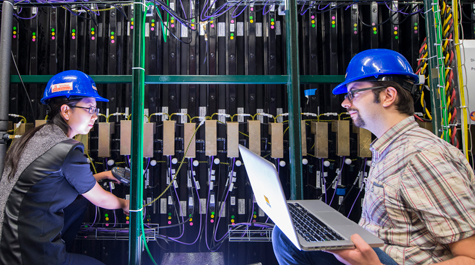In ‘Nature’: Machine learning keeps particle physicists from a Lucy-and-Ethel situation
It’s a common comedy trope: the industrial production line that speeds up beyond the limits of the humans who must work on it.
Particle physicists found themselves facing a potential Lucy-and-Ethel candy-factory future as they planned more- and more-advanced experiments designed to generate data at rates that would overwhelm entire armies of human analysts.
Happily for physicists, their colleagues in computer science were making advances that provided algorithm-driven methods to process and analyze the data from experiments at facilities such as CERN, Fermilab and SLAC. Alexander Radovic, a postdoctoral research associate in the Department of Physics at William & Mary, is the lead author on a review article that looks at how artificial intelligence is used in the quest to understand the fundamental particles of nature.
The paper, “Machine learning at the energy and intensity frontiers of particle physics,” is in the Aug. 2 issue of the journal Nature.
“It's targeted at scientists more generally rather that just particle physicists,” Radovic wrote in an email from his base outside Chicago at Fermilab. “Ideally, I’d like it to be seen as some hybrid of resource, road map and rallying cry.”
Radovic and his co-authors show how Big Data techniques are being used to process data that is not only big in terms of volume, but equally big in terms of complexity. Compared to physicists, Lucy and Ethel had it easy: Their candy factory produced the same bon-bons at an increased rate. Imagine the candy machine suddenly switching between chocolate-covered pretzels, candy bars, cakes, puddings, etc.
Physicists working at the Department of Energy’s Fermilab facility and other experiments such as those based at the Large Hadron Collider have a weightier task than wrapping candy. They are using billion-dollar instruments to try to wrap up understanding of the Standard Model, the inventory of particles and interactions on which the universe operates.
The opening of the Nature paper notes that the Standard Model is incomplete in that it doesn’t incorporate dark matter — or even gravity. Experiments aimed at understanding those final knotty bits of the Standard Model — and looking for the physics beyond the Standard Model’s framework— requires a great deal of data and data analysis
“That’s why we need machine learning rather than simple human-written algorithms,” Radovic explained. Machine learning is a techniques that uses algorithms designed to improve the operation of computers based on predictive analysis of data.
In machine learning, the computer essentially “teaches” itself and Radovic’s paper deals with the various tests necessary to validate the different machine-learning tools and quantify the uncertainties built into the process: “What model has our network learned? What is the uncertainty on its prediction?“
“As we’re trying to provide measurements with well-described uncertainties, we're even more interested in the question of bias or reliability,” he said.
The paper emphasizes neural networks being used in LHC experiments. Radovic points out that the Higgs discovery was a high-profile event, “and honestly, they have more scientists, so there is more work to mention.”
Radovic also covered machine-learning aspects in neutrino research. It’s only natural, as he is a neutrino researcher at Fermilab, where he convenes a major neutrino oscillation group on the NOvA experiment, on which he has made important contributions to deep-learning tools. (“We punch way above our weight in terms of authors,” he said.)
Radovic said that he hopes exposure in Nature will attract a wide readership to the paper, and notes that concepts of machine learning, neural networks and artificial intelligence have applications far beyond particle physics.
“I hope that some of the problems we struggle with will correlate in fruitful ways with those of other disciplines, including the concerns of social sciences like ethical AI,” he said.
















